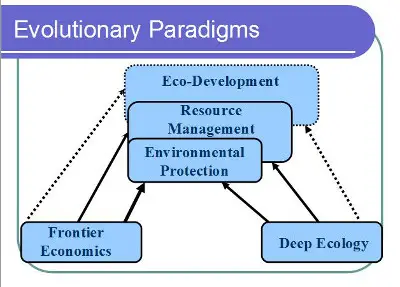Man’s treatment of the environment defines its integrity. Find out how perception can enhance, destroy or sustain use of the environment to meet human needs.
The way man treats the environment depends on how he perceives it. What does this statement mean in the context of environmental management?
To explain how this works, the following diagram (Figure 1) showing the evolution of environmental perspectives is presented. It summarizes the five evolutionary paradigms of human-environment interactions[1].
At the bottom of the diagram lies two opposing ideologies on how man should treat the environment. These are frontier economics and deep ecology thinking.
Frontier economics thinking is an environmental perspective that prevailed in industrial economies of developed countries until the rise of environmentalism around the 1960s. This environmental perspective is founded on the belief that nature is an infinite supply of physical resources including raw materials, energy, water, soil, and air. These resources are present mainly for human benefit. Nature is treated as an infinite sink (!) of resource consumption by-products in the form of pollution and ecological degradation. Adherents of this environmental perspective do not recognize a biophysical “environment” to be managed because it is considered irrelevant to the economy.
Deep ecology thinking, on the other hand, promotes symbiosis or mutually beneficial relationship between nature and man. Nature, in this instance, is given more emphasis in this environmental perspective. Deep ecologists expect the world to return to pre-industrial, rural lifestyles and simple standards of living to meet human physical needs. This environmental perspective recognizes that the earth’s “supplies” is limited, so it must be protected at all costs. Return to traditional ways that advocate preservation of nature is given prime importance [2].
In the hope of integrating human needs or harmonizing these needs with the environment which serves as resource supplier, three other dominant paradigms arose through the years. These are environmental protection, resource management, and eco-development.
The environmental protection perspective came into focus with Rachel Carson’s (1962) Silent Spring book that revolutionized the environmental movement. The book was instrumental in the creation of the now well-known US Environmental Protection Agency (EPA). Rachel Louise Carson was an American marine biologist and conservationist whose book Silent Spring and other writings are credited with advancing the global environmental movement[3]. Her work along with other scientists linked synthetic pesticides like dichlorodiphenyltrichloroethane (DDT) with near extinction of bird species. Shell thinning of bird eggs due to DDT caused death of birds through bioaccumulation; thus, silent spring ensued as there are no birds to sing their melodious songs.
To address problems of environmental pollution, the environment must be protected. The perspective focuses on repairing and setting limits to harmful economic activities and uses the “end of pipe” or “business-as-usual”, plus a treatment plant” approach.
The resource management environmental perspective appears to be the ideal approach to environmental management nowadays. It promotes wise use of resources through regulation of human behavior and activities. Natural resources, both tangible and intangible, are used in an organized and efficient manner. Resources referred to here include land, water, labor, capital, organization, skills, as well as people’s belief systems. It is believed that traditional ways are compatible uses of the environment because these practices have evolved through time and are desirable for continued survival. Greater emphasis is given on long-term sustainability of resource use and development activity. This environmental perspective encourages energy efficiency, resource conservation, pollution prevention, ecological restoration, ecosystem and social health monitoring, and “polluter pays” principle. The economy is embedded within the ecosystem.
Lastly, the eco-development environmental perspective champions restructuring of the relationship between society and nature into a “positive sum game” through sophisticated symbiosis. Economic restructuring incorporates ecological principles. It integrates all the concerns of other perspectives. Man and nature should co-evolve. It advocates “green development “where land use planning includes consideration of community-wide or regional environmental implications of development, as well as site-specific concerns.
References:
[1] Colby, Michael E. 1989. The evolution of paradigms of environmental management in development. Strategic Planning Division, Strategic Planning and Review Department, The World Bank. 34 pp.
[2] Lear, Linda (1997). Rachel Carson: Witness for Nature. New York: Henry Holt. ISBN 0-8050-3428-5.
© 2013 January 3 P. A. Regoniel



very useful